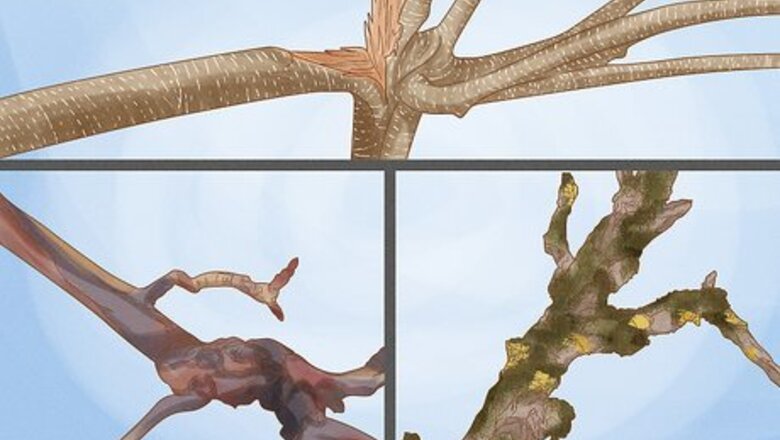
views
Removing Old Branches
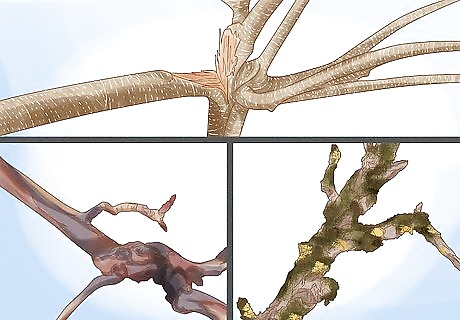
Prune any dead or damaged branches. Dead, damaged or diseased wood should be removed starting with the origin of the damage. This may mean cutting an entire large area if it is all damaged or dead. You will know if an area is damaged or dead if it does not have leaves during growing season when the rest of the tree is in bloom. Removing dead or damaged branches is one of the few times it’s okay to prune your tree in the spring or summer.
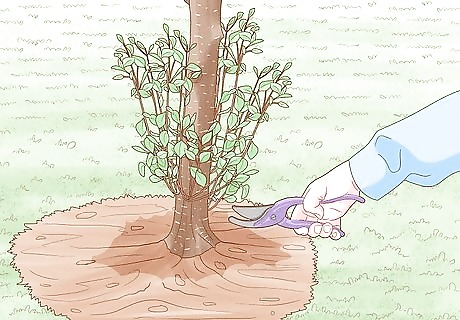
Cut sprouts coming from the base of the trunk. If you have sprouts growing down near the bottom of the tree out of the main trunk, these are called “suckers” and are actually part of the root system, not the fruiting system on top. They don’t have any purpose on your pear tree. Prune these spouts off right at their origin up against the trunk.
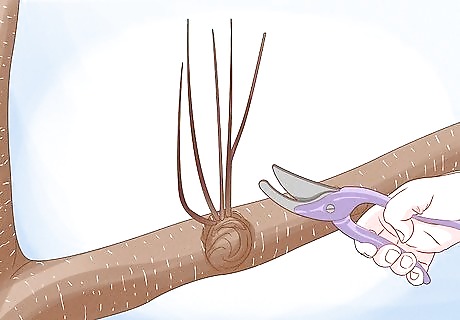
Remove straight vertical sprouts coming from main branches. If you see any suspiciously straight, vertical sprouts growing from a branch of your tree, that’s a "water sprout." They look different from other branches because they occur on main branches, have no curve, are somewhat short, and grow straight up toward the sky. Water sprouts have no purpose on your tree and should be cut at their point of origin on the main branch they’re growing out of.

Avoid cutting fruiting spurs most of the time. Fruiting spurs grow on branches that were originally grown two years previously, so you don’t need to worry about them on very young trees. They look like smaller curved branches growing off a main branch, with little bud-like shapes, or fruit buds, at the tip. Fruiting spurs usually take 1 or 2 years to grow fruit. The year after fruiting, another 1 or 2 fruit buds will appear in that spot. After 6 or 7 years, the spur will become congested with fruit buds and then you can prune them to allow new fruiting spurs to grow elsewhere. The only other reason to cut them is if the branch is dead or damaged.
Making Cuts on Your Tree

Prune during the winter on a dry day. Pruning your pear tree during its dormant season before it actively begins regrowth in the spring is best because the tree will put more energy into growing where it was pruned. Pruning during this time when the leaves are off the tree also allows for you to better see what you’re doing. You should also choose a dry day to prune your pear tree. If it’s raining or snowing when you cut your tree, there’s a higher risk of infection getting into the wet cuts.
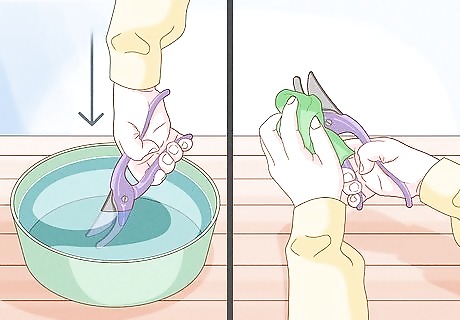
Have a sharp, clean set of shears or pruning saw. If your shears or saw are old and you’re not sure if they are sharp, you can either sharpen them yourself or take them to your local hardware store to have them sharpened for a small fee To clean your shears or saw yourself, dip the blades in isopropyl alcohol for 30 seconds to disinfect them, then wipe them dry with a clean towel.
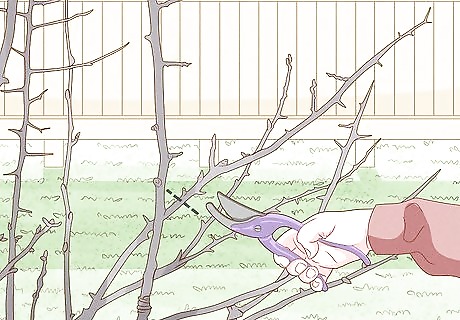
Make slanted cuts that are flush with the branches. Cuts that are slightly slanted will help deter water from soaking into the cut and having your branch get infected. You want to also want to make cuts right against the larger branch that the branch you're removing is growing from. Avoid leaving little stubs when you make cuts. Make a clean, slanted cut right up against the larger branch.
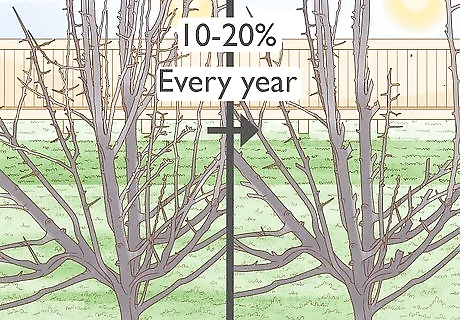
Cut 10-20% of your tree each year. If your tree is healthy, aim to remove 10-20% of the overall canopy of your tree in one year. This will mean more for older trees, and not much at all for younger trees. If you prune too hard, your tree may produce the vigorous upright branches called water sprouts which will start to crowd your tree. If your pruning pile starts looking a little big, or more than 10-20% of your tree, it’s time to stop immediately. Wait until next year to prune more.
Shaping Your Tree
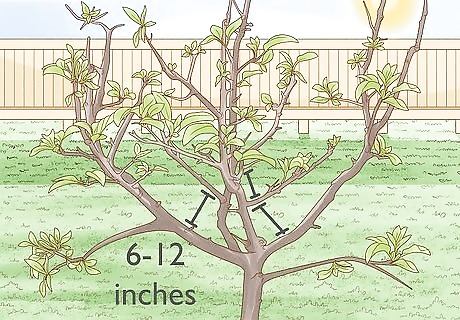
Aim for a wine-glass shape with evenly spaced branches. Overall, you want your pear tree to be shaped like a wine glass, with the trunk as the glass stem and the branches in an even, outwardly splayed growth. Allow for about 6–12 inches (15–30 cm) of air space between healthy branches to allow for good air circulation and to reduce the risk of fungal infections. Occasionally step back from your tree and look at the overall shape as you’re pruning, to ensure that you’re getting the right shape and clearing away crowded areas effectively.
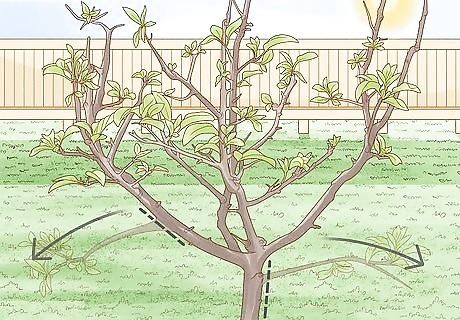
Remove branches that grow downward. You want your pear tree branches to grow outward and slightly upward. If you have branches that are growing downward, prune these at their point of origin at the bigger branch. Your overall goal is to have a tree with evenly spaced branches that splay out in a pleasing visual pattern from the center.
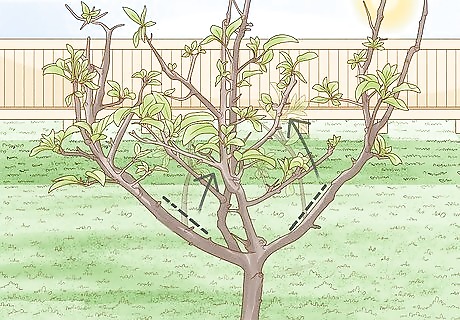
Prune branches that grow toward your tree’s center. Branches that grow against the main flow of outward, upward branches will crowd your other branches and cause an overall chaotic look in your tree. Prune these branches at their point of origin where they meet a bigger branch.
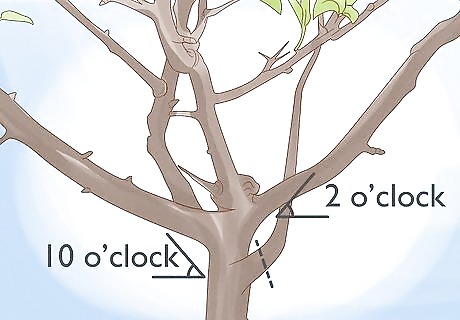
Thin out competing branches. If you find two or more branches growing from a single space at a narrow angle, or from different points in a parallel fashion and they hover toward each other, choose the healthiest appearing branch to keep and prune the rest. The branch you keep should also have the best angle at its origin, which is around a 2 o’clock or 10 o’clock angle from the center of the tree. Branches with wider angles can break easily when they bear fruit.




















Comments
0 comment